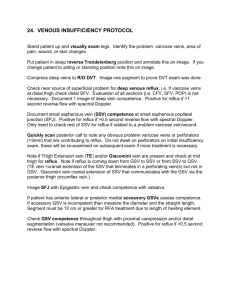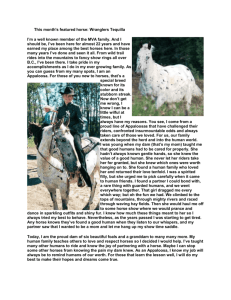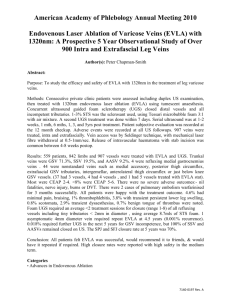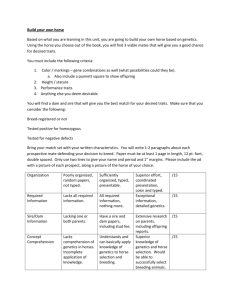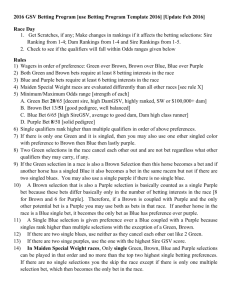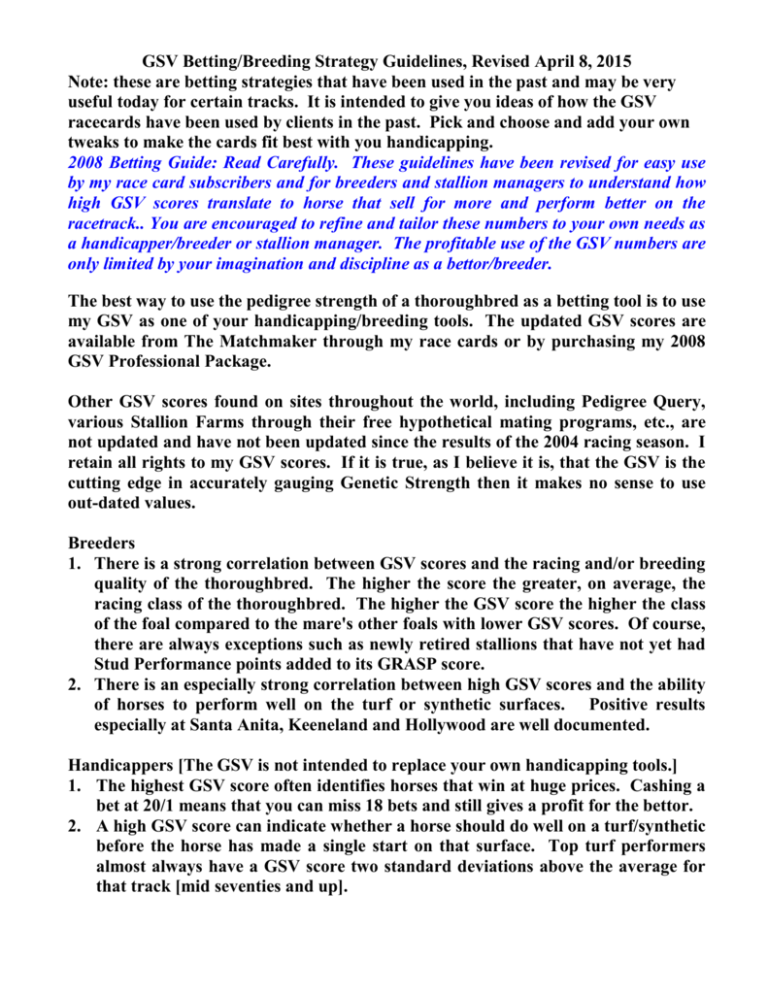
GSV Betting/Breeding Strategy Guidelines, Revised April 8, 2015
Note: these are betting strategies that have been used in the past and may be very
useful today for certain tracks. It is intended to give you ideas of how the GSV
racecards have been used by clients in the past. Pick and choose and add your own
tweaks to make the cards fit best with you handicapping.
2008 Betting Guide: Read Carefully. These guidelines have been revised for easy use
by my race card subscribers and for breeders and stallion managers to understand how
high GSV scores translate to horse that sell for more and perform better on the
racetrack.. You are encouraged to refine and tailor these numbers to your own needs as
a handicapper/breeder or stallion manager. The profitable use of the GSV numbers are
only limited by your imagination and discipline as a bettor/breeder.
The best way to use the pedigree strength of a thoroughbred as a betting tool is to use
my GSV as one of your handicapping/breeding tools. The updated GSV scores are
available from The Matchmaker through my race cards or by purchasing my 2008
GSV Professional Package.
Other GSV scores found on sites throughout the world, including Pedigree Query,
various Stallion Farms through their free hypothetical mating programs, etc., are
not updated and have not been updated since the results of the 2004 racing season. I
retain all rights to my GSV scores. If it is true, as I believe it is, that the GSV is the
cutting edge in accurately gauging Genetic Strength then it makes no sense to use
out-dated values.
Breeders
1. There is a strong correlation between GSV scores and the racing and/or breeding
quality of the thoroughbred. The higher the score the greater, on average, the
racing class of the thoroughbred. The higher the GSV score the higher the class
of the foal compared to the mare's other foals with lower GSV scores. Of course,
there are always exceptions such as newly retired stallions that have not yet had
Stud Performance points added to its GRASP score.
2. There is an especially strong correlation between high GSV scores and the ability
of horses to perform well on the turf or synthetic surfaces. Positive results
especially at Santa Anita, Keeneland and Hollywood are well documented.
Handicappers [The GSV is not intended to replace your own handicapping tools.]
1. The highest GSV score often identifies horses that win at huge prices. Cashing a
bet at 20/1 means that you can miss 18 bets and still gives a profit for the bettor.
2. A high GSV score can indicate whether a horse should do well on a turf/synthetic
before the horse has made a single start on that surface. Top turf performers
almost always have a GSV score two standard deviations above the average for
that track [mid seventies and up].
3. A high GSV score can indicate whether a horse has the stamina to run is a race
over classic distances as there is a stamina bias built into the program.
4. A race where most of the runners have a GSV score greater than 70, usually
indicates a Classic race that is on dirt or good races on synthetic or turf.
5. If a race has one or more horses with GSV scores above two standard deviations,
it indicates a significant edge of these horses over the rest of the field and a flat
win bet is producing a good profit at most tracks.
6. Currently, the GSV program has also shown great promise by betting the highest
GSV scores in a race. The standards to base a bet on the sire, dam or the horse
are listed below: Update 2015: Changes in the program have greatly reduced
these numbers but the differences between tracks are still valid.
Listed below are the GSV numbers with the necessary standard deviations for selected race tracks
Track
GSVMean + 1 SD
Dam GSV Mean+.7*SD
Aqueduct
73.66
73.29
ArlingtonPark
74.23
73.40
BelmontPark
74.46
73.87
ChurchillDowns
74.23
73.95
DelawarePark
74.92
74.43
DelMar
72.25
72.44
HollywoodPark
72.50
72.17
Keeneland
75.39
75.03
NorthlandsPark
70.39
68.76
SantaAnita
72.91
72.48
StampedePark
70.59
69.40
Woodbine
72.28
71.68
Frequently Asked Questions about the Professional GSV Program and Race Cards
1. What is the difference between the GSV1, GSV2 and GSV scores?
A. The GSV1 is the old original GSV number taking both sides of the pedigree into consideration
beginning at the first generation. The 1st gen is worked out, then the 2nd generation, then 3rd,
then 4th , then the 5th generation. All five generations are averaged to give the GSV1 score.
B. The GSV is the same except that I work out the male half and female half of the pedigree
separately in the manner I did with the GSV1. I then add the score I got from the male half
and the score I got from the female half and average them, which I call the GSV score.
C. To obtain the GSV2 score, I use my extensive databank to determine the average GSV score
for each stallion in the databank. The difference between the average GSV score of the sire of
the horse and the GSV of a particular horse is called my UP score. The GSV score plus the
UP score are then added together to produce the GSV2 score. UP scores have a range from 0
to +5.00 [negative scores = 0, positive scores have a maximum of +5.00].
2. Which score is best to use betting?
A. The GSV is the best score to use betting, though the GSV2 is also another great betting tool since
it includes the UP score, which tells one how much better or worse this horse is on paper than
other horses by the same sire. The GSV2 score is used more in analyzing broodmares and
stallions by The Matchmaker and the strength of the most recent mating.
3. Why is the GSV and GSV2 score the same in some horses?
A. Since negative UP scores are not allowed, they are given a score of 0.
B. This might also be a case where the sire of the horse being given a GSV score is not represented
by any other horse in the databank. Since there are no other horses to give the sire an average, the
UP score is 0 and therefore the GSV2 score is the same as the GSV.
C. © George William Smith, The Matchmaker, August 3, 2008 All rights reserved
GSV Betting/Breeding Strategy Guidelines, Revised January 28, 2010
Read Carefully. These guidelines have been revised for easy use by my race card
subscribers and for breeders and stallion managers to understand how high GSV scores
translate to horse that sell for more and perform better on the racetrack.. You are
encouraged to refine and tailor these numbers to your own needs as a
handicapper/breeder or stallion manager. The profitable use of the GSV numbers are
only limited by your imagination and discipline as a bettor/breeder.
The best way to use the pedigree strength of a thoroughbred as a betting tool is to use
my GSV as one of your handicapping/breeding tools. The updated GSV scores are
available from The Matchmaker through my race cards or by purchasing my 2010
GSV Professional Package.
Other GSV scores found on sites throughout the world, including Pedigree Query,
various Stallion Farms through their free hypothetical mating programs, etc., are
not updated and have not been updated since the results of the 2004 racing season. I
retain all rights to my GSV scores. If it is true, as I believe it is, that the GSV is the
cutting edge in accurately gauging Genetic Strength then it makes no sense to use
out-dated values.
New Method (1/28/2010) Playing the GSV on a Limited Budget
This is the latest GSV adaptation now being tested by The Matchmaker using his GSV race cards
In Claiming Races on all surfaces:
1. If no horse meets the standard of 77 in the Sire, Dam or GSV, bet the horse with the
highest GSV score to win only.
2. If only one horse meets the standard in at least one of the 3 groupings bet that horse to
win and if another horse has the highest GSV in the race [no matter the score] box the
two in an exacta [Santa Anita [1/28/2010], Miss Annie, DamGSV = 77.69, $41.20, I
Swear, highest GSV =71.72 combined for a $1, $168.10 Exacta
3. If two or more horses have met the standard in one or more of the categories, box the
horse with the highest GSV to the horse with the highest qualifying DamGSV or if
none, then the horse with the highest qualifying SireGSV.
In Non-claiming races on all surfaces:
This bet is basically the same as for claiming races except add:
1. Bet the highest GSV horse to win and place if it also has a qualifying GSV or Dam
GSV or Sire GSV >77.00, otherwise just bet the horse to win like in claiming races.
2. Box the horse with the highest GSV with the horse that has the highest DamGSV,
regardless of their GSV scores [the horses are in an non-claiming race for a
reason][Mayomast $12.20 (highest GSV 73.01) and Pearl Esque (highest DamGSV
71.87 combined for a $2 exacta that paid $271.00 at Tampa Bay, 1/27/2010].
Breeders
3. There is a strong correlation between GSV scores and the racing and/or breeding
quality of the thoroughbred. The higher the score the greater, on average, the racing
class of the thoroughbred. The higher the GSV score the higher the class of the foal
compared to the mare's other foals with lower GSV scores. Of course, there are
always exceptions such as newly retired stallions that have not yet had Stud
Performance points added to its GRASP score.
4. There is an especially strong correlation between high GSV scores and the ability of
horses to perform well on the turf or synthetic surfaces. Positive results especially at
Santa Anita, Keeneland and Hollywood are well documented.
Handicappers [The GSV is not intended to replace your own handicapping tools.]
7. The highest GSV score often identifies horses that win at huge prices. Cashing a bet
at 20/1 means that you can miss 18 bets and still gives a profit for the bettor.
8. A high GSV score can indicate whether a horse should do well on a turf/synthetic
before the horse has made a single start on that surface. Top turf performers almost
always have a GSV score two standard deviations above the average for that track
[mid seventies and up].
9. A high GSV score can indicate whether a horse has the stamina to run is a race over
classic distances as there is a stamina bias built into the program.
10. A race where most of the runners have a GSV score greater than 70, usually indicates
a Classic race that is on dirt or good races on synthetic or turf.
11. If a race has one or more horses with GSV scores above two standard deviations, it
indicates a significant edge of these horses over the rest of the field and a flat win bet
is producing a good profit at most tracks.
12. Currently, the GSV program has also shown great promise by betting the highest GSV
scores in a race. The standards to base a bet on the sire, dam or the horse are below:
Listed below are the GSV numbers with the necessary standard deviations for selected race tracks
Track
GSV Mean+ 1SD
Dam GSV Mean+.7*SD
Aqueduct
73.66
73.29
ArlingtonPark
74.23
73.40
BelmontPark
74.46
73.87
ChurchillDowns
74.23
73.95
DelawarePark
74.92
74.43
DelMar
72.25
72.44
HollywoodPark
72.50
72.17
Keeneland
NorthlandsPark
SantaAnita
StampedePark
Woodbine
75.39
70.39
72.91
70.59
72.28
75.03
68.76
72.48
69.40
71.68
In 2010, I am using a score of 77.00 for betting purposes if one or more horses meet
that standard
Frequently Asked Questions about the Professional GSV Program and Race Cards
4. What is the difference between the GSV1, GSV2 and GSV scores?
D. The GSV1 is the old original GSV number taking both sides of the pedigree into consideration
beginning at the first generation. The 1st gen is worked out, then the 2nd generation, then 3rd,
then 4th , then the 5th generation. All five generations are averaged to give the GSV1 score.
E. The GSV is the same except that I work out the male half and female half of the pedigree
separately in the manner I did with the GSV1. I then add the score I got from the male half
and the score I got from the female half and average them, which I call the GSV score.
F. To obtain the GSV2 score, I use my extensive databank to determine the average GSV score
for each stallion in the databank. The difference between the average GSV score of the sire of
the horse and the GSV of a particular horse is called my UP score. The GSV score plus the
UP score are then added together to produce the GSV2 score. UP scores have a range from 0
to +5.00 [negative scores = 0, positive scores have a maximum of +5.00].
5. Which score is best to use betting?
B. The GSV is the best score to use betting, though the GSV2 is also another great betting tool since
it includes the UP score, which tells one how much better or worse this horse is on paper than
other horses by the same sire. The GSV2 score is used more in analyzing broodmares and
stallions by The Matchmaker and the strength of the most recent mating.
6. Why is the GSV and GSV2 score the same in some horses?
D. Since negative UP scores are not allowed, they are given a score of 0.
E. This might also be a case where the sire of the horse being given a GSV score is not represented
by any other horse in the databank. Since there are no other horses to give the sire an average, the
UP score is 0 and therefore the GSV2 score is the same as the GSV.
F. © George William Smith, The Matchmaker, January 28, 2010, All rights reserved
New method instituted in 2014
Genetic Strength Value Plays, featuring the Dam Dominance, Dam Special and Pedigree Plays
The highest payoff in the Pedigree, Dam Dominance and Special Play is well over $100 for a
$2 win ticket in each of the categories and earned by different horses from November 1 to
December 19, 2014 at one of the tracks at which I generated GSV race cards.
Rule #1: There must be at least 7 separate betting interests in the race. The larger the field,
the greater the payoff on average for a successful GSV bet.
Rule #2: In the Pedigree Play, there will be only one horse to play. This horse will be
ranked either 1 or 2 in the Sire column and 1 or 2 in the Dam column and #1 in the GSV.
The total ranking points must be either 3 or 4 by adding up all three column rankings.
Therefore, it might be ranked 1 or 2 in Sire or Dam column, but not both of these because
the total ranking points would then be at least 5 [2+2+1=5]. The Sire GSV score must be
above 71. The Dam GSV score must be above 73 and the GSV score for the horse must be
above 72 and all three scores [RT] added together must be 3 or 4.
Rule #3: In the Dam Dominance play, the Dam GSV score must be at least 5 points higher
than the GSV score of the horse, which means that the Dam GSV is significantly higher than
the Sire GSV and pay off in boxcar prices because handicappers do not generally recognize
the strength of the female half of the pedigree. The GSV score + 8 points must be greater
than the Dam GSV score to ensure there is enough Sire strength in the pedigree. The Dam
GSV score must be greater than 71.
The highest ranked Dam Dominance GSV horse almost always is a better value bet and may
even be a better bet where there are multiple horses selected in the race that have higher
Dam GSV ranking horses. The exception would be where the Dam GSV and GSV rankings
are both #1. A good example of this bet is the following Santa Anita Play. Note Gotham
News DS and Ped plays are ranked only #2 and #1 and not both #1.
Rule #4: In the Dam Special Play, the Dam GSV score must be above 69 and a more
balanced pedigree than the Dam Dominance play. The Dam GSV score + 2 must be greater
than the GSV score of the horse, which means the Sire has a significantly high GSV score
and the GSV score is ranked in the top 4 in the field. The major limiting factor in this play
is that the Dam GSV must be ranked #1. With the Dam GSV rankings there is a significant
drop in the number of winners after the Top 2 rankings and the payoffs are significantly
less so going deeper is not a smart play.
Rule #5: If there are two selections in the Dam Dominance or Dam Special columns, use the
highest ranked dam play on the doubled column, but a link [same horse is picked in two
different columns is always preferred.
Note: Scratches significantly alter the rankings and rankings are generally more important
that the GSV scores themselves. Make changes in the rankings on your sheets first.
1. If there is only one play in a race, play that horse if it is less than 70/1. If you don’t like
the value, then skip the race, but never be afraid to bet a GSV play at long odds.
2. The Pedigree and Dam Special play are often both selected [linked]. An example is
Take Charge Brandi in the Breeders' Cup, which paid off $123.40 for a $2 bet.
3. If there is a Dam Special bet and a Dam Dominance play, play the Dam Special bet
unless there are two Dam Dominance plays, then use the highest ranked Dam
Dominance play. If there is a Dam Dominance play and a Pedigree bet or a Dam Special
play use the value play, which is usually the the Dam Dominance or Dam Special play.
4. It is possible to have 3 or more bets in the Dam Dominance play, but I recommend
passing the race unless you were already interested in one of the three.
5. Note: Sometimes a scratch will push the Dam Dominance play into a higher ranking,
which then gives it too many points for that longshot bet. Therefore, I prefer to add the
number of horses entered to my betting sheet before scratches to see if any such
horses are identified. I will often still play them, even though they are technically not a
bet.
6. Recheck if two dam dominances and 1 special play and the special play is a better bet
than best of the two dam dominance plays in DamGSV ranking


